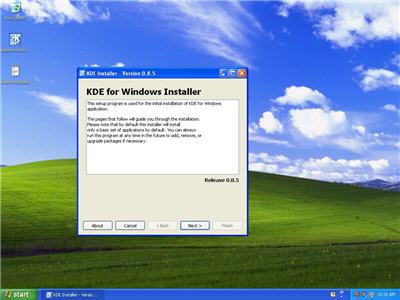KDE 4 for Windows

Over the past few days several of you have suggested that I take a look at the new KDE 4 for Windows. Well, yesterday I downloaded the installer and took a look - and I'm pretty impressed by what I've seen so far.
KDE stands for K Desktop Environment and this is free software that provides an easy to use and application rich desktop environment. KDE's origins are rooted in Linux but the latest release brings with it support for both Windows and Mac.
Check out the KDE for Windows gallery here.
The KDE 4 port for Windows is far from completed yet (it's described as alpha by the developers) and rather than offering a desktop environment, the idea is to offer support for KDE applications. Vista isn't yet supported but the package does support Windows 2000, Windows XP and Windows 2003.
With that in mind I fired up an XP virtual machine and got installing. The process isn't that complicated but you do need to remember to download the appropriate packages (I missed out this step to begin with, but once I got my act together). I bought in dbus-msvc, kdebase-msvc, kdewin32-msvc, qt-msvc, and kdegames-msvc. After everything is done (the process takes a while so I took this opportunity to do something else) you then have to remember to change the Windows environment variables.
And that's it. Now it's just a case of digging about in the bin folder and running executables. Sure, not the most civilized way to run applications, but remember, this is alpha stuff. As far as the apps themselves, they're a mixed bunch. Games mostly play well, but Konqueror is slower than erosion. KDE help centers are also unavailable, which is a bit of a downside for people like me who aren't that familiar with the applications.
The porting of KDE to Windows could result in some interesting things happening. First, it acts are a bridge between KDE apps which have been tied to Linux and brings them to Windows. But it could also lead to a full-blown KDE desktop environment for Windows, and that could be very interesting indeed.
Thoughts?
